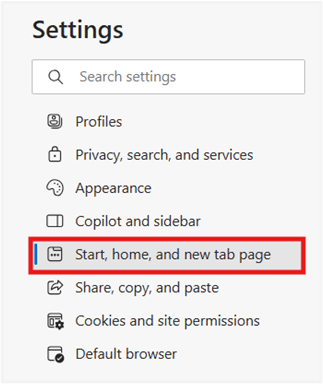Microsoft Edge preloads a New Tab page (NTP) in the background, allowing users to access it faster. This feature enhances page loading performance, but may also use up additional network, CPU, and memory resources. Users in bandwidth-sensitive environments or operating on low-resource devices may want to disable this feature to enhance device performance.
This guide discusses several ways to enable or disable preloading the NTP in Microsoft Edge on Windows 11.
How to disable Microsoft Edge’s Preload New Tab page behavior
By default, NTP preloads on Microsoft Edge. Users and IT administrators can easily configure this behavior to suit their needs better. This section explores how you can do this using Edge’s browser settings, Registry Editor, Command Prompt, PowerShell, and Group Policy Editor.
📌 Prerequisites: For the methods to work, ensure that you have the following requirements:
- Microsoft Edge ver. 102 or later
- Windows 11 OS
📌 Recommended deployment strategies:
Choose a Method | 💻 Best for Individual Users | 💻💻💻 Best for Enterprises |
| Method 1: Configuring Browser Settings | ✓ | |
| Method 2: Registry Editor | ✓ | |
| Method 3: Command Prompt | ✓ | |
| Method 4: PowerShell | ✓ | |
| Method 5: Group Policy Editor | ✓ |
Method 1: Changing the browser settings
Users can directly enable or disable preloading the New Tab page on Microsoft Edge via browser settings. This is the most straightforward, easily reversible, and risk-free method.
📌 Use Cases: This method is ideal for:
- Users on a personal device
- Users with no administrator privileges
- Users who prefer a straightforward GUI method
To use this method, simply follow the steps below:
- Open Microsoft Edge and go to edge://settings/
- Navigate to Start, home, and new tab page.

- Under the New tab page, look for Preload your new tab page for a faster experience. Toggle the switch on or off to suit your preferences.
- Restart your browser to apply the changes.
Method 2: Registry modification approach
Modifying the registry is another way to adjust the preload settings. This approach allows the changes to be implemented per-user or system-wide.
📌 Use Cases: Registry modification is ideal for:
- Advanced users who prefer more granular control over configuration
- IT administrators who are making manual changes to a small number of devices
- Testing policy effects before enterprise-wide deployment
📌 Prerequisites: This method requires users to have administrator privileges.
⚠️ WARNING: Editing the registry can cause system issues. Create a backup before proceeding. The Things to look out for section explains more about potential risks with this method.
To modify the registry, follow these steps:
- Open Registry Editor.
- Navigate to the correct path:
- For changes to the current user, go to
HKEY_CURRENT_USER\Software\Policies\Microsoft\Edge - For system-wide changes, go to
HKEY_LOCAL_MACHINE\Software\Policies\Microsoft\Edge - If the Edge key does not exist, then the user must create it.
- For changes to the current user, go to
- Add a new DWORD (32-bit) Value named NewTabPagePrerenderEnabled.
- Set the value to your desired setting:
- Use 1 to enable preloading the New tab page
- Use 0 to disable preloading the New tab page
- Close Registry Editor and restart Microsoft Edge to apply changes.
💡 Note: Other methods may also show registry paths that start with HKCU or HKLM. Paths with HCKU correspond to HKEY_CURRENT_USER, meaning all changes will apply only to the currently logged-in user; HKLM corresponds to HKEY_LOCAL_MACHINE, and changes made on this path will apply system-wide and affect all users on the device. You can learn more about this in the Things to look out for section.
Method 3: Using the Command Prompt to change the preload setting
📌 Use Case: Command Prompt use is ideal for scripting environments, batch processing, or tech support scenarios where changes need to be applied quickly via command-line tools
📌 Prerequisites: This method requires administrator privileges.
To make changes via Command Prompt:
- Open Command Prompt as an administrator.
- Execute the following commands:
- To disable preloading the New tab page for the current user:
reg add “HKCU\Software\Policies\Microsoft\Edge” /v NewTabPagePrerenderEnabled /t REG_DWORD /d 0 /f - To enable preloading the New tab page for all users:
reg add “HKLM\Software\Policies\Microsoft\Edge” /v NewTabPagePrerenderEnabled /t REG_DWORD /d 1 /f
- To disable preloading the New tab page for the current user:
- Close and reopen Microsoft Edge to apply the setting.
Method 4: Automate changes via PowerShell
📌 Use Case: PowerShell is commonly used to automate repetitive and time-consuming tasks.
📌 Prerequisites: This method requires administrator privileges.
To automate enabling or disabling this setting on PowerShell, use the following commands:
- Disable preloading NTP for the current user:
New-Item -Path “HKCU:\Software\Policies\Microsoft\Edge” -Force | Out-Null
Set-ItemProperty -Path “HKCU:\Software\Policies\Microsoft\Edge” -Name “NewTabPagePrerenderEnabled” -Value 0 -Type DWord - Enable system-wide preloading:
New-Item -Path “HKLM:\Software\Policies\Microsoft\Edge” -Force | Out-Null
Set-ItemProperty -Path “HKLM:\Software\Policies\Microsoft\Edge” -Name “NewTabPagePrerenderEnabled” -Value 1 -Type DWord
Once done, restart Edge or open a new tab to verify if changes have taken effect.
Method 5: Applying enterprise-wide changes with the Group Policy Editor
📌 Use Case: Group Policy Editor is best used for enterprise-wide deployment.
📌 Prerequisites: This method requires the following:
- Administrator privileges
- Windows 11 Pro, Education, or Enterprise editions (⚠️ Important: This method will not work on a Windows 11 Home edition.)
To use the Group Policy Editor:
- Open Group Policy Editor.
- Navigate to Computer Configuration (or User Configuration) > Preferences > Windows Settings > Registry.
- Add a new Registry Item:
- Action: Update
- Hive: HKEY_CURRENT_USER (or HKEY_LOCAL_MACHINE)
- Key Path: Software\Policies\Microsoft\Edge
- Value Name: NewTabPagePrerenderEnabled
- Value Type: REG_DWORD
- Value Data: 1 (enable) or 0 (disable)
- Link the GPO to the relevant OU and run gpupdate /force to force a policy change.
⚠️ Important: Ensure that you are linking to the correct OU; otherwise, the settings may not apply to your chosen devices. Read more about this risk in the Things to look out for section. - Restart Microsoft Edge to apply the changes.
⚠️ Things to look out for
| Risks | Potential Consequences | Reversals |
| Registry misconfigurations | The policy may not be applied, or the system may experience instability. | Restore your backed-up Windows Registry. |
| Incorrect registry scopes (misuse of HKCU vs HKLM) Applicable for Methods 2-5 | The policy may be misapplied, or the registry may be corrupted. | For registry modifications, restore your Windows Registry backup. For Command Prompt changes, use reg delete to remove the incorrect command or to execute the correct command. |
| The policy is linked to the incorrect OU. | Settings are applied to the wrong users or devices. | Unlink the incorrect GPO and link to the correct OU scope. |
Additional considerations before modifying Microsoft Edge’s preload page settings
If you’re unsure whether changing the preload settings is right for you, then keep the following considerations in mind:
Resource usage
Keeping the preload new tab page option enabled gives users a faster browsing experience, but it will use resources. This trade-off may not be ideal for low bandwidths and shared resources. However, Microsoft Edge also offers Efficiency Mode and Sleeping Tabs–two features that can help with resource optimization. Consider whether configuring the browser’s different settings and features is enough to minimize resource usage.
Impacted behavior on Microsoft Edge
Disabling the preload option affects only New Tab Page behavior. It will not impact browsing history or favorites.
Control scope
This consideration is particularly important when using the Registry method, Command Prompt, and PowerShell. All three methods allow users to configure settings for only the current user or the whole system. Be mindful of using HKCU vs HKLM; HKCU affects only the current user, while HKLM affects the local machine.
Troubleshooting
Changes are not being applied
If your changes are not applied, then you may have forgotten to restart Microsoft Edge. Restart the browser first and verify if your desired settings are now working. If you used the Group Policy Editor to disable the preload, then you can also force a group policy update.
If the changes still haven’t been applied, check your policies (or contact your IT administrator) to verify if there are no conflicting policies.
Preload toggle is missing on Microsoft Edge
If the preload toggle is missing, verify if you are using the correct Microsoft Edge version. For the methods above to work, users need to have version 102 or later. Older versions will not have the “Preload your new tab page for a faster experience” feature.
Enhance system performance and user browsing by tweaking Microsoft Edge’s preload behavior
Adjusting the preloading behavior of the New Tab Page in Edge ensures optimal resource use based on organizational needs. The methods above provide various ways to effectively configure the feature, based on your administrative privileges, desired scope, and specific use case.
Related topics:
- How to Enable or Disable Restore Pages Dialog Prompt in Microsoft Edge in Windows 11
- How to Disable Microsoft Edge from Launching at Startup in Windows
- How to Enable or Disable Tracking Prevention in Microsoft Edge
- How to Enable or Disable Autofill in Microsoft Edge in Windows 10
- How to Enable or Disable Send Do Not Track Requests in Microsoft Edge in Windows 10









